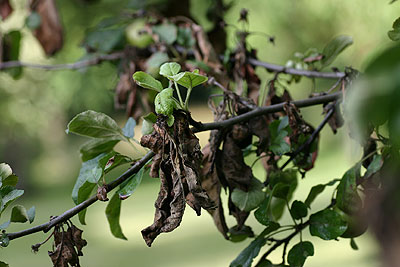 |
| Fire blight in apple. Photo by Sebastian Stabinger, from https://en.wikipedia.org/wiki/File:Apple_tree_with_fire_blight.jpg |
By C.J. Walke
The Debate
Since the inception of the National Organic Program (NOP) in 2002, the antibiotics tetracycline and streptomycin have been approved for use in apple and pear production to combat fire blight (Erwinia amylovora), a bacterial disease that affects the pome family. This is the only place in the NOP rule where antibiotics are allowed. These materials had been approved for use in organic production until October 21, 2014, and this April, the National Organic Standards Board (NOSB) met to decide whether to extend that deadline. The board voted to uphold the current deadline, so after 2014, antibiotics will not be allowed in apple and pear production.
Opponents of this use of antibiotics say the materials are not allowed anywhere else in organic production, so why in apple and pear cultivation? They are prohibited from use in the European Union, as is the sale of fruit produced with antibiotics. An estimated 80 percent of annual antibiotic sales in the United States are for use in the agricultural sector, mostly in livestock production. Other concerns are that these antibiotics are used to fight infectious diseases in humans, and their use in agriculture and on our food could lead to antibiotic resistance in these human ailments.
Proponents argue for their need as tools in the orchard toolbox to fight a disease that can kill trees and can spread rapidly throughout an orchard when environmental conditions are right. One fire blight canker can infect a few acres of apple and/or pear trees. Proponents also say that no other approved materials are available as alternatives, and to prohibit antibiotic use would leave no protection against the disease. Two new products are in the testing phase, however – Blossom Protect, a yeast-based product, and Previsto, a copper product. Both show some effectiveness.
Fire Blight Control
Fire blight is not common in Maine, so we are spared major concern for now – although it is a disease that apple and pear growers need to watch for diligently. However, in the western United States, where most organic apples and pears are grown, fire blight is a serious concern. The primary infection window is during bloom when temperatures rise above 80 F and the air is humid. When blossoms are open, they provide a clear path to the tree’s vascular system and easy entry for the bacteria to colonize and start the infection.
Initial signs of infection are typically either blossom blight, where the open flowers wilt and turn brown or black, and shoot blight, where young shoots are bent over, forming the characteristic “shepherd’s crook,” and turning black. The blackening of the leaves, as if they were scorched by fire, gives the disease its name. The bacteria can also spread through limbs and trunk, forming cankers, as well as down into the root system of the tree, usually killing the tree. The shepherd’s crook is typically the easiest and earliest sign to observe, and if found, it needs to be dealt with immediately.
The best cultural method is to prune out infected shoots or cankers by using the “ugly-stub” method. (Remember, the NOP rule allows the use of permitted and/or restricted materials only if cultural methods are not effective.) This method goes against all the pruning recommendations you’ve read and against what you’ve learned at MOFGA’s pruning workshops, but its focus is disease management. The first step is to prune the affected shoot or limb 8 to 12 inches below the affected area, leaving an ugly stub of a branch to stop the disease from spreading farther down the limb. DISINFECT YOUR TOOLS! Clean them with rubbing alcohol between each cut.
Then destroy the shoot (fight fire with fire) and mark the ugly stub for pruning during the dormant season. The reasoning is that the bacteria are present in your orchard, so when you make that first pruning cut, the bacteria will likely colonize the newly exposed tissue. If you made a proper pruning cut, the disease would be farther down the limb and would most likely enter one of the main scaffolds. So leave the stub, mark it clearly, then prune and destroy it in the dormant season. Again, don’t forget to disinfect your tools!
Fire blight is not very common in Maine, although it does occur in the southern part of the state, but nowhere near the severity with which fruit growers in the South and West have to contend.
Also, consider the susceptibility of different cultivars or varieties when you choose trees to plant. An extensive list is posted here: www.ext.colostate.edu/pubs/garden/02907.html.
I expect fire blight occurrence will increase as our average temperatures rise, so education and preparation are the best defenses in the organic orchard.
C.J. Walke is MOFGA’s organic orchardist and librarian. You can address your orcharding questions to him at 568-4142 or [email protected].
